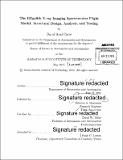| dc.contributor.advisor | Rebecca A. Masterson and David W. Miller. | en_US |
| dc.contributor.author | Carte, David Brad | en_US |
| dc.contributor.other | Massachusetts Institute of Technology. Department of Aeronautics and Astronautics. | en_US |
| dc.date.accessioned | 2015-09-17T19:13:23Z | |
| dc.date.available | 2015-09-17T19:13:23Z | |
| dc.date.copyright | 2015 | en_US |
| dc.date.issued | 2015 | en_US |
| dc.identifier.uri | http://hdl.handle.net/1721.1/98805 | |
| dc.description | Thesis: S.M., Massachusetts Institute of Technology, Department of Aeronautics and Astronautics, 2015. | en_US |
| dc.description | Cataloged from PDF version of thesis. | en_US |
| dc.description | Includes bibliographical references (pages 177-181). | en_US |
| dc.description.abstract | Engineers of space flight programs face unique technical challenges created by the space environment in which these systems operate. High costs and increasing complexity of space programs create a greater demand for mission reliability. This demand further drives up development costs and project time lines. The result is that few missions are flown and few organization are able to participate in space program development. Project budget and schedule overruns are in part a result of a risk-averse culture and the desire the create fail-proof systems. Resource constrained programs will have difficulty developing successful space systems if they attempt to fully address every risk. Rather, by taking a risk-tolerant posture, resource-constrained programs can more efficiently allocate resources to the most important areas of a system's development. By focusing effort and resources on high-risk areas, successful space programs can still be developed with lower budgets and smaller schedules than has traditionally been done. Recent attempts to lower the time and budgets necessary to develop space systems have focused on developing smaller, less complex, and more numerous space system to replace traditionally larger, more expensive systems. The benefits of small space systems range from distributing risk across multiple systems and thereby lowering the cost of failure, to providing smaller organizations and universities the capabilities to develop their own space systems. Though these programs are cheaper, many organizations of small space systems are faced with limited resources that must be intelligently allocated to develop successful space programs. This thesis presents the structural design, analysis, and testing of the REgolith Xray Imaging Spectrometer (REXIS), a student-led instrument on board the National Aeronautics and Space Administration (NASA) Origins Spectral Interpretation Resource Identification and Security-Regolith Explorer (OSIRIS-REx) asteroid sample return mission. As part a student experiment, the REXIS team must develop its system under tight resource constraints. The limited funding, personnel, equipment, and facilities available to the REXIS team all have important implications on how design, analysis, and testing decisions are made on REXIS. This thesis provides a discussion of key areas of the REXIS structural development and lessons learned from a structural engineering point of view. Chapter 1 opens the discussion by talking about the motivation behind this thesis. It provides background information to the REXIS instrument and the context for the rest of the instrument discussion. The REXIS flight structural design and how this design facilitates the accomplishment of REXIS goals is presented in Chapter 2. Next, the analysis and testing of the Radiation Cover, one of REXIS's most critical elements, is described in Chapter 3. The key efforts taken on the REXIS structural development is discussed in Chapter 4. This particular section, through the discussion of the chronological development of the REXIS flight structural design, will highlight important areas of where efforts was focused on REXIS within the project constraints. Lastly, Chapter 5 provides lessons learned from a structural engineering point of view from the experiences on REXIS. Although the discussion focuses on the REXIS structural development, the examples and discussions described are relevant to other programs. This thesis is meant to provide insight into the REXIS development from which engineers of future small space programs can learn. | en_US |
| dc.description.statementofresponsibility | by David Brad Carte. | en_US |
| dc.format.extent | 181 pages | en_US |
| dc.language.iso | eng | en_US |
| dc.publisher | Massachusetts Institute of Technology | en_US |
| dc.rights | M.I.T. theses are protected by copyright. They may be viewed from this source for any purpose, but reproduction or distribution in any format is prohibited without written permission. See provided URL for inquiries about permission. | en_US |
| dc.rights.uri | http://dspace.mit.edu/handle/1721.1/7582 | en_US |
| dc.subject | Aeronautics and Astronautics. | en_US |
| dc.title | The REgolith X-ray Imaging Spectrometer flight model : structural design, analysis, and testing | en_US |
| dc.type | Thesis | en_US |
| dc.description.degree | S.M. | en_US |
| dc.contributor.department | Massachusetts Institute of Technology. Department of Aeronautics and Astronautics | |
| dc.identifier.oclc | 921146900 | en_US |
